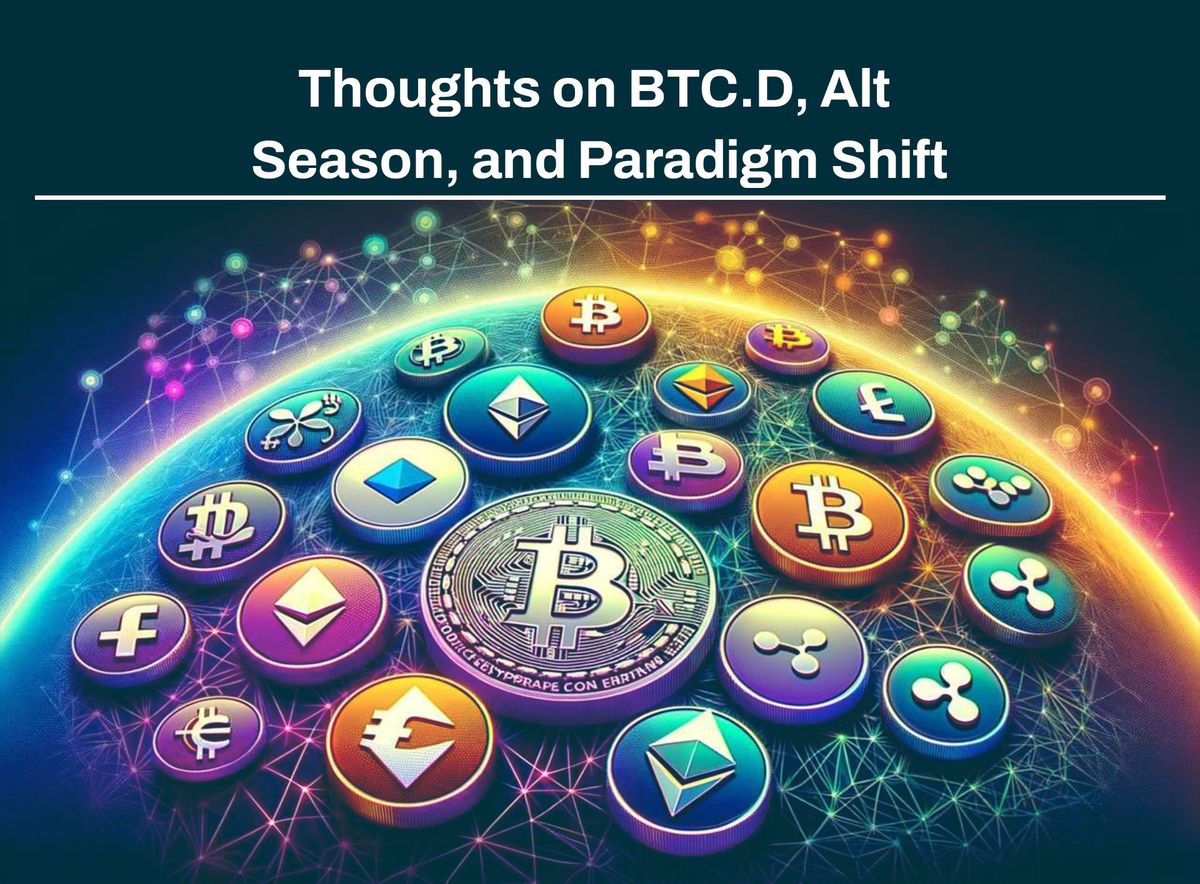Thoughts on BTC.D, Alt Season, and Paradigm Shift
This cycle, starting in Q4 2022, has played out differently. Instead of the usual sequence of BTC pumping, then ETH, then a broad altcoin rally, we’ve seen BTC pump first, ETH follow, and then whatever happens to be the hot trend that quarter takes off.

In the last cycle, the major blindspot was the expectation of a "super cycle" that never materialized.
Everything started to unravel when people realized that Plan B's model was flawed, and the anticipated $100K target for Bitcoin was not going to happen.
This cycle’s blindspot might be the expectation of an "alt season"—a period when "ticker symbols become everything."
Traditionally, you’d open Binance, buy almost any token, and wake up with gains, often without any research or due diligence. This approach worked in previous cycles, but it’s been somewhat different this time around (while still following a familiar pattern).
In past cycles, we’d see Bitcoin pump first, followed by Ethereum, and then the altcoins. The further down you went on CoinGecko, the harder the pumps were. Typically, people would start by buying BTC, experiment with ETH, and eventually venture into altcoins as they became more comfortable with risk. Gains of around 20% in BTC or ETH would often be rotated into riskier altcoins, aiming for 3-4x returns, before taking profits and reinvesting back into BTC or ETH.
This cycle, starting in Q4 2022, has played out differently. Instead of the usual sequence of BTC pumping, then ETH, then a broad altcoin rally, we’ve seen BTC pump first, ETH follow, and then whatever happens to be the hot trend that quarter takes off. This might be ordinals, runes, ERC404, Solana, pump-and-fun tokens, meme coins, TON, Layer-1 projects, AI, or AI-powered meme coins—there’s always a new trend gaining momentum.
Interestingly, even the meme coin of the quarter seems to rotate, with a different one surging every few months.
If you’re not invested in the hot trend or the meme coin of the moment, you’re likely to underperform BTC, ETH, and increasingly SOL. This cycle has emphasized constant rotation, with “narrative trading” becoming the dominant strategy.
It feels like the paradigm has shifted—we’re seeing crypto start to resemble traditional finance.
We may be entering a “coin-picking” era similar to stock-picking in TradFi, where outperforming the market (like the S&P 500) requires an edge in selecting stocks, as with Cathie Wood. In crypto, to outperform BTC, ETH, and SOL, you now need to become an expert in coin selection.
The days of buying any random coin and watching it pump are largely over—tough luck for newcomers in this cycle. You can’t just buy the 34th-ranked token on CoinGecko or the 17th trending coin on Binance, go to bed, and expect to wake up wealthy.
Some call this the “meme coin era” or the “anti-VC token era,” and while both are true, they’re part of a larger trend.
With BTC and ETH ETFs now available and a SOL ETF on the way, new entrants are naturally drawn to these major assets over smaller ones like ARB, FTM, or any lesser-known coin.
These ETFs bring steady demand to BTC, ETH, and soon SOL, making it harder to outperform them by simply spreading $50 across ten random projects. Investing now requires a much more thoughtful, meticulous approach.
People aren’t entering crypto through BTC and ETH only to later explore riskier assets. Instead, they’re diving straight into the high-risk side of the market.
I foresee a “barbell strategy” emerging, where portfolios consist mainly of the big three—BTC, ETH, and SOL—on one end and meme coins or the latest quarterly trend on the other. Passive investments will likely be in BTC, ETH, and SOL via indexes, funds, or ETFs, while active bets will be on trending meme coins and quarterly hypes.
I can’t imagine people holding passive positions outside the big three, such as in CRO or BLUR.
Whether a token is VC-backed, low float, or high FDV seems irrelevant; I don’t see those investments becoming common again.
Some point to the decline in BTC dominance as a signal for an alt season, noting its peak over 60 and current downward trend. But similar claims have been made at 30, 40, 50, and even 60 BTC.D.
No one expected BTC.D to reach 60 this year, and while I do think it has peaked, it’s not because an alt season is imminent. Instead, ETH and SOL have started to perform again. ETH, with the largest market cap relative to BTC, has underperformed BTC for three years, so it’s reasonable that BTC.D went up as ETH/BTC declined.
The key point is that BTC dominance (BTC.D) is mainly influenced by high-market-cap coins, not lower-cap assets like AR or the 77th-ranked token on CoinGecko.
When major players like SOL, ETH, DOGE, SHIB, and SUI pump, BTC.D declines because these assets have substantial market caps.
If large-cap coins continue to outperform BTC, BTC.D will likely keep declining. But a drop in BTC.D doesn’t mean a broad altcoin season is coming. Even ETH, the second-largest asset, hasn’t outperformed BTC in the past three years—so it’s unlikely that smaller altcoins will suddenly outshine BTC.
If you have a competitive edge, you might be able to invest successfully in each quarter’s hottest trend or the latest meme coin. Otherwise, you’re probably better off focusing on the big three: BTC, ETH, and SOL.
Disclaimer: The views and opinions expressed in this article are those of the author and do not necessarily reflect the official policy or position of Obiex.
Obiex is not responsible for the accuracy, completeness, or validity of any information provided in this article.
